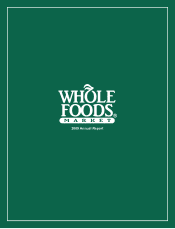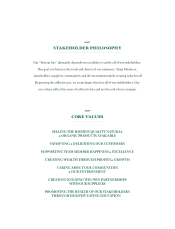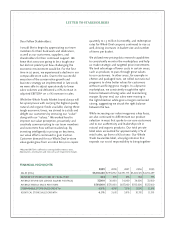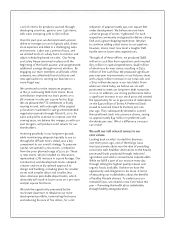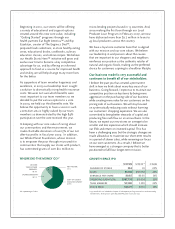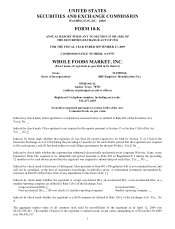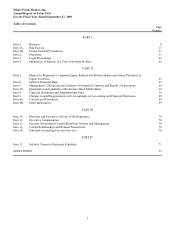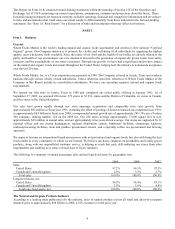Whole Foods 2009 Annual Report Download - page 11
Download and view the complete annual report
Please find page 11 of the 2009 Whole Foods annual report below. You can navigate through the pages in the report by either clicking on the pages listed below, or by using the keyword search tool below to find specific information within the annual report. 5
We believe the growth in sales of natural and organic foods is being driven by numerous factors, including:
• heightened awareness of the role that food and nutrition play in long-term health, which has led to healthier eating
patterns;
• a better-educated and wealthier populace whose median age is increasing each year;
• increasing consumer concern over the purity and safety of food due to the presence of pesticide residues, growth
hormones, artificial ingredients and other chemicals, and genetically engineered ingredients; and
• environmental concerns due to the degradation of water and soil quality.
Natural foods can be defined as foods that are minimally processed, largely or completely free of artificial ingredients,
preservatives and other non-naturally occurring chemicals and as near to their whole, natural state as possible. Organic foods
are grown through methods intended to support and enhance the earth’s natural balance. Generally, organic food products are
produced using:
• agricultural management practices intended to promote and enhance ecosystem health;
• no genetically engineered seeds or crops, sewage sludge, long-lasting pesticides, herbicides or fungicides;
• livestock management practices intended to promote healthy, humanely treated animals by providing organically
grown feed, fresh air and outdoor access while using no antibiotics or growth hormones; and
• food processing practices intended to protect the integrity of the organic product and disallow irradiation,
genetically modified organisms (“GMOs”) or synthetic preservatives.
Organic Rule
In October 2002, the United States Department of Agriculture’s (“USDA”) Organic Rule was implemented into Federal law.
The Organic Rule was created to address the rapid, consistent growth of the organics industry over the past 20-plus years and
the need for a set of national organic standards to serve as clear guidelines as to what is considered organic for the industry
and its customers. Under the Organic Rule, all products labeled as “organic” in any form must be certified by a USDA-
accredited certifying agency. Furthermore, all retailers, including Whole Foods Market, that handle, store, and sell organic
products must implement measures to protect their organic integrity by:
• preventing the commingling of organic and conventional products;
• protecting organic products from contact with prohibited substances (such as sanitation and pest control products);
• labeling organic products properly and clearly; and
• keeping proper records with regard to organic handling procedures and vendor relationships.
Whole Foods Market played an active leadership role in the development of the national organic standards. Margaret
Wittenberg, our Global Vice President of Quality Standards and Public Affairs, served on the National Organic Standards
Board (“NOSB”) from 1995 to 2000. The NOSB members were appointed by the Secretary of Agriculture to act as industry
advisors to the USDA’s National Organic Program, developing the standards and protocols that form the backbone of the
USDA’s Organic Rule. As the sole retail representative on the NOSB, Ms. Wittenberg contributed a broad, realistic
perspective on how the standards could work most effectively at the retail level.
In fiscal year 2009, U.S. Agriculture Secretary Tom Vilsack appointed Joe Dickson, our Food, Organic and Environmental
Quality Standards Coordinator, to serve as one of five new board members on the National Organic Standards Board from
2010 through 2015.
Whole Foods Market has been devoted to protecting organic integrity for years, and we are pleased to have the USDA’s
Organic Rule as a guiding standard. In May 2003, Whole Foods Market became America’s first national “Certified Organic”
grocer through certification by a federally recognized independent third-party certification organization. In July 2009,
California Certified Organic Growers (“CCOF”), one of the oldest and largest USDA-accredited third-party organic
certifiers, individually certified each of our stores in the U.S., complying with stricter guidance on federal regulations. This
voluntary certification tells our customers that we have gone the extra mile by not only following the USDA’s Organic Rule,
but opening our stores up to third-party inspectors and following a strict set of operating procedures designed to ensure that
the products we sell and label as organic are indeed organic – procedures that are not specifically required by the Organic
Rule.
This certification verifies our handling of organic goods according to stringent national guidelines, from receipt through re-
packing to final sale to customers. To receive certification, retailers must agree to adhere to a strict set of standards set forth
by the USDA, submit documentation, and open their facilities to on-site inspections – all designed to assure Americans that
the chain of organic integrity is preserved. The certification is one more example of our commitment to the promotion of
organic agriculture and the integrity of the certified organic label.

